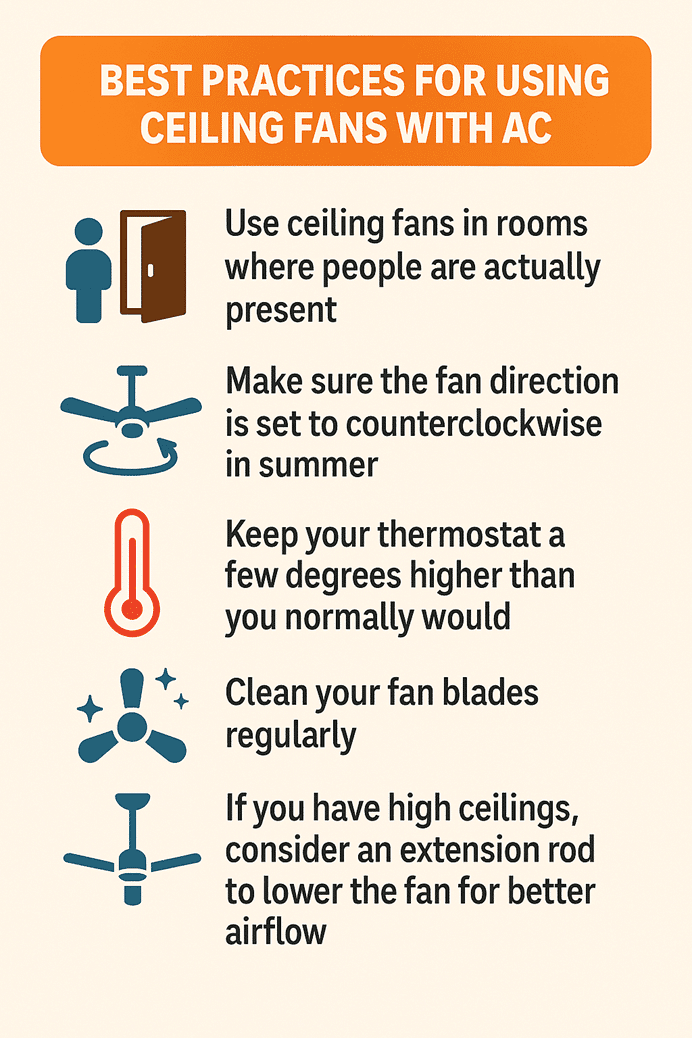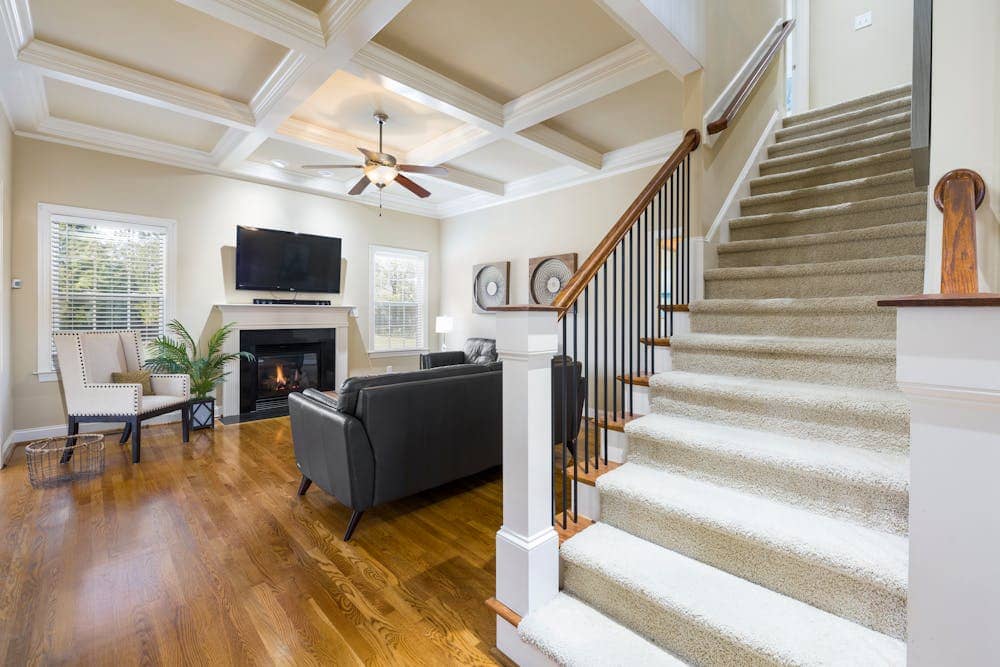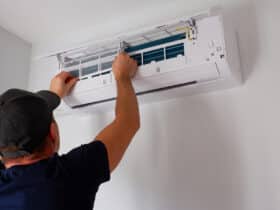When the summer heat kicks in, lots of homeowners wonder: Should I run my ceiling fans along with my air conditioner, or is that just wasting energy? It’s one of the most common questions I hear when I’m out doing HVAC calls, and the short answer is yes, ceiling fans can absolutely help your AC work better, but only if you understand how they actually work. The problem is, plenty of people run them wrong and end up paying for extra electricity without feeling cooler.
So let’s get real about how ceiling fans and air conditioning work together, why air movement matters, and how to use your fans the right way to stay comfortable and save money.
How Ceiling Fans Really Work (It’s Not What You Think)
A lot of folks think ceiling fans cool the air in a room, but that’s not technically true. Fans don’t lower the temperature of the air; they just move it around. What they really do is create a wind-chill effect on your skin. When the air moves across your body, it helps sweat evaporate faster, which makes you feel a few degrees cooler.
That’s why you should never run a ceiling fan in an empty room. Unlike your AC, which changes the temperature of the air, your fan only cools people, not the room. So if no one’s there to feel that breeze, you’re just wasting energy.
Why Ceiling Fans Can Make Your AC More Efficient
So, how does a ceiling fan help your AC? Here’s the key: when you feel cooler thanks to that breeze, you can set your thermostat a few degrees higher without feeling uncomfortable. This is where the real energy savings come in.
For example, if you normally set your AC to 72°F, you might feel just as comfortable at 76°F if you’ve got a ceiling fan gently circulating the air. According to the Department of Energy, each degree you raise your thermostat can save you about 3% on your cooling costs. That adds up fast over a whole summer.
Plus, fans help mix up pockets of air that tend to get trapped near the ceiling or in corners, so your AC doesn’t have to work as hard to maintain an even temperature throughout your home.
The Right Direction Really Does Matter
Here’s a classic mistake I see all the time: ceiling fans spinning the wrong way. Most people don’t even know you can change the direction, but it makes a big difference.
In summer, you want your ceiling fan spinning counterclockwise. This pushes air straight down, creating that cool breeze on your skin. In winter, you’d flip it to spin clockwise on a low speed to gently pull cooler air up and push warm air down along the walls.
So take a minute to grab a step stool and check the direction switch on your fan, it’s usually on the side of the motor housing. If you stand under the fan and feel a breeze, you’re good for summer.
Where Ceiling Fans Really Make a Difference
In my years working on AC units in older homes, I’ve seen ceiling fans make the biggest difference in places where air circulation is naturally poor, like upstairs bedrooms or stuffy living rooms with vaulted ceilings.
Hot air rises, so your upstairs is always going to feel warmer than your ground floor. Running ceiling fans upstairs can help pull that heat back down into the airflow so your AC doesn’t have to run as long to bring temps down.
Open-concept layouts and big rooms with high ceilings often have temperature differences of 5–10 degrees between the ceiling and the floor. Fans help even that out, so you’re not blasting your AC all day just to cool off the spots where you actually live.
Common Fan Mistakes That Waste Money
I can’t tell you how many homes I walk into where ceiling fans are running in empty rooms, day and night. Remember, fans cool people, not rooms. If you’re leaving fans on when you’re not there, you’re adding to your electric bill with zero benefit.
Another big mistake is cranking fans on high, thinking that more breeze is always better. In reality, you want a gentle, steady breeze that’s enough to boost that wind-chill effect without blowing your papers across the room or drying out your eyes. Medium speed is usually fine for most rooms.
Should You Use a Ceiling Fan with AC at Night?
This is another question I hear a lot, especially from folks who like to sleep with the fan on. If your bedroom tends to get stuffy, a ceiling fan can absolutely help your AC keep you comfortable at night just make sure it’s blowing downward in the summer direction.
If you’re sensitive to noise or dry eyes, a quiet, balanced fan on low speed is your friend. And again, don’t forget to switch it off in the morning if you’re not in the room.
How Much Can Ceiling Fans Actually Save You?
Let’s put some numbers to it. Running a standard ceiling fan costs about 1–2 cents per hour, way cheaper than lowering your thermostat. According to the Department of Energy, using a ceiling fan properly lets you raise your AC setting by about 4 degrees with no loss in comfort. That can shave up to 10% off your cooling costs over a season.
If you live in a region with high humidity, you’ll benefit even more, since moving air helps sweat evaporate, making sticky days feel a lot more tolerable.
Best Practices for Using Ceiling Fans with AC

So here’s the real HVAC pro advice I always give my customers:
- Use ceiling fans in rooms where people are actually present and turn them off when you leave.
- Make sure the fan direction is set to counterclockwise in summer.
- Keep your thermostat a few degrees higher than you normally would, and you’ll save money without sacrificing comfort.
- Clean your fan blades regularly dusty blades scatter dirt into your air, which your AC filter has to catch.
- If you have high ceilings, consider an extension rod to lower the fan for better airflow.
Do You Need a Ceiling Fan in Every Room?
Not necessarily. Prioritize the rooms you spend the most time in living rooms, bedrooms, and home offices. In spaces that already get good cross-breezes or have small square footage, a fan might not make much difference.
For homes with older or undersized AC systems, adding fans in key areas can take a surprising amount of pressure off your air conditioner. That can extend the life of your unit and prevent that dreaded “AC runs all day but never cools down” problem I see every summer.
The Bottom Line: Yes, Fans Really Do Help If You Use Them Right
So, do ceiling fans really help your AC? 100% yes, but only if you use them the right way. They don’t lower the air temperature, but they make you feel cooler, so your AC can take a break. That means lower bills, better comfort, and less wear and tear on your system.
If you’re looking for the best way to beat the heat without burning through your budget, a simple ceiling fan spinning in the right direction, used when you’re actually in the room, is one of the cheapest energy-saving hacks around.
So flip that switch, feel the breeze, and let your AC take it easy this summer. You’ll stay comfortable, and your wallet will thank you.










